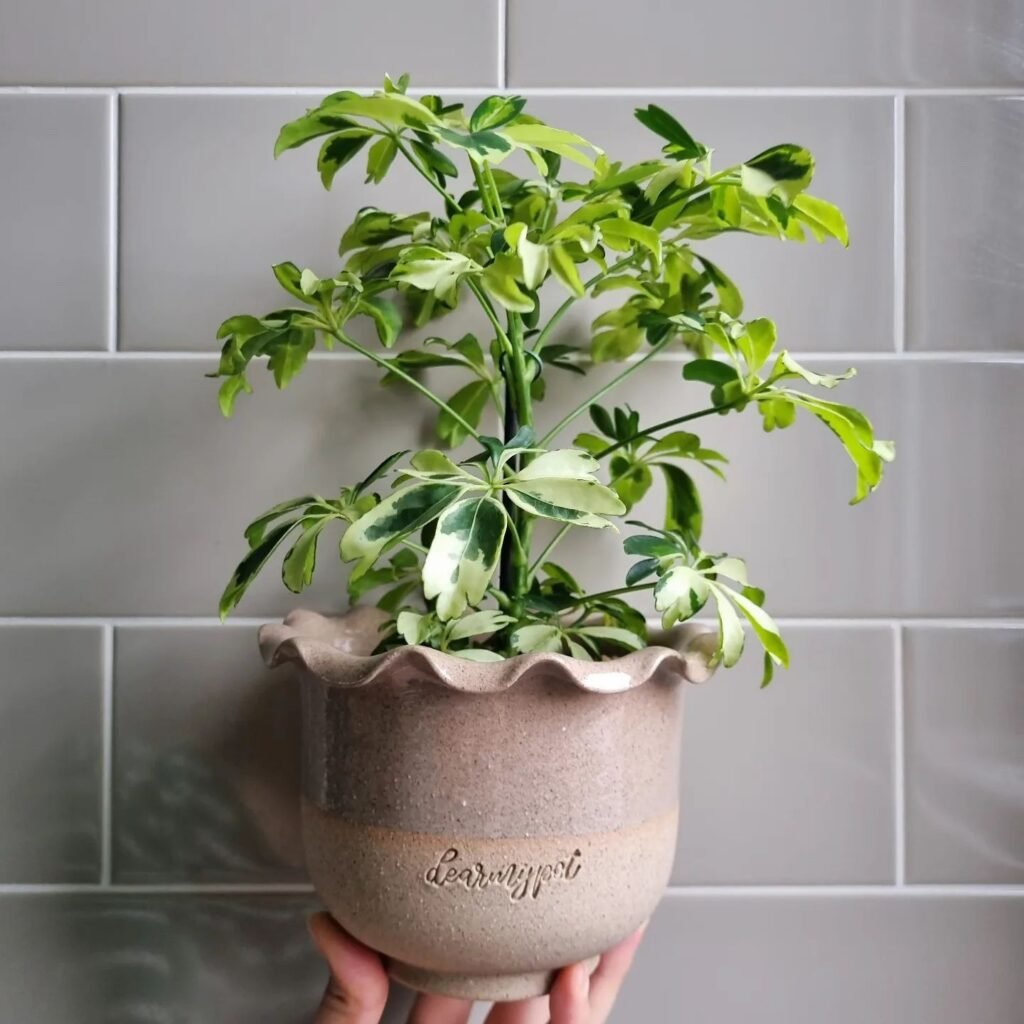Imagine walking into my bright and airy living room, greeted by a burst of vibrant greenery. Nestled in the corner, basking in the soft morning light, is my beloved Schefflera Janine, also known as the Umbrella Plant. Its broad, glossy leaves fan out like the sheltering canopy of an umbrella, instantly transforming the space into a tropical paradise.
I’ve always been drawn to indoor plants, and the Schefflera Janine is undoubtedly one of my favorites. With its lush foliage and striking appearance, it brings a sense of life and energy to my home in the UK, even on the grayest of days. And the best part? It thrives indoors, making it the perfect companion for those of us with a passion for houseplants.
While Schefflera Janine is native to tropical regions, it adapts well to our UK climate. Its dwarf varieties can reach heights of up to 3m, adding a touch of drama to any room. So, whether you’re a seasoned plant parent or new to the world of indoor gardening, caring for a Schefflera Janine is a rewarding experience that will bring nature’s beauty right into your home.
Appearance of Schefflera Janine (Umbrella Plant)
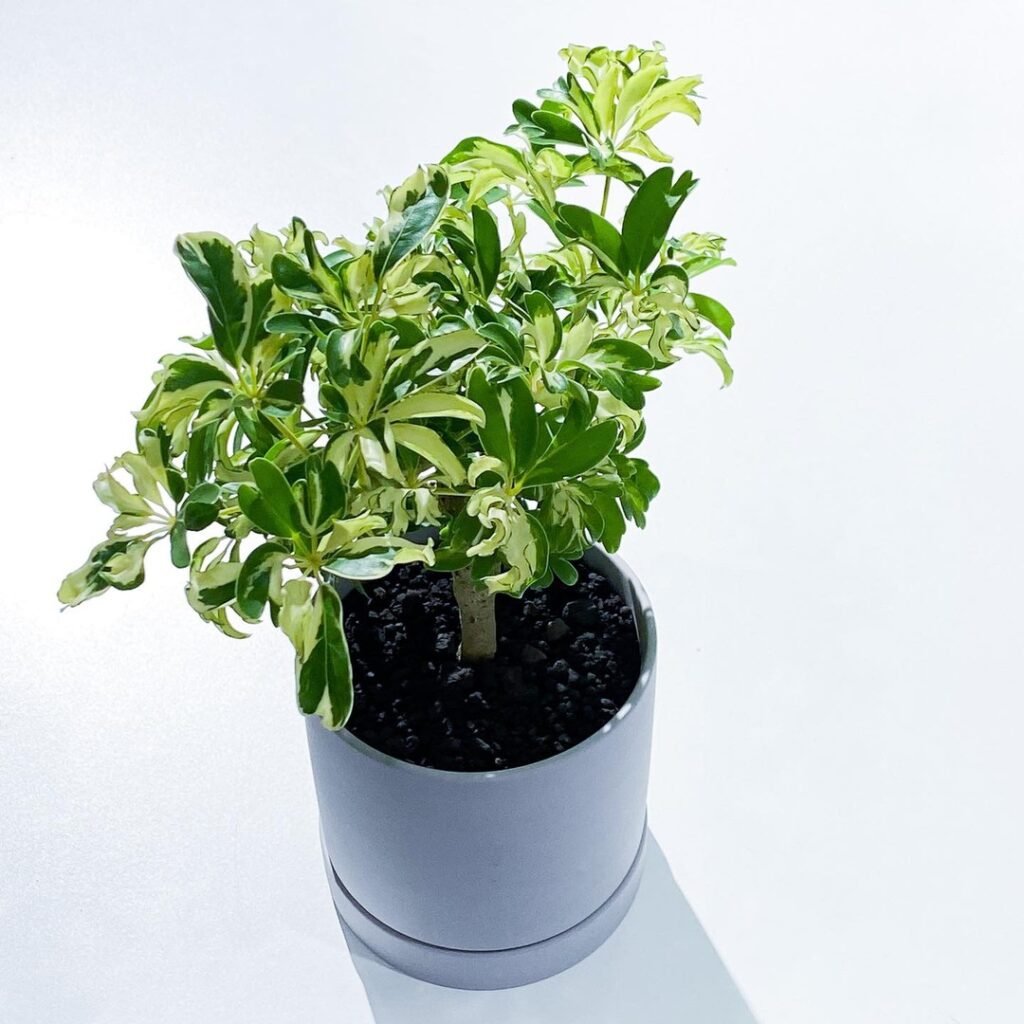
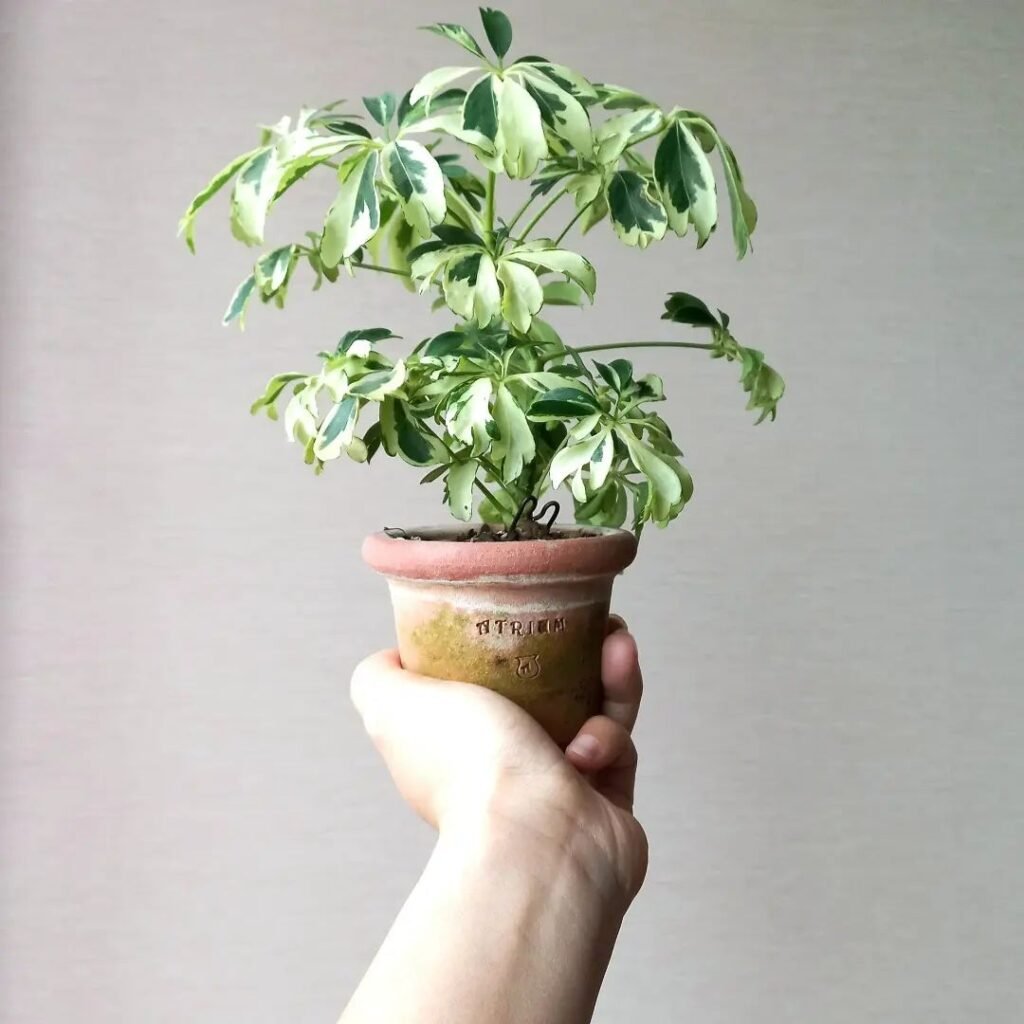
Schefflera Janine, also known as the Umbrella Plant, is a tropical indoor plant that features broad-leaved foliage in an umbrella-like arrangement. The glossy leaves come in various shapes and sizes, depending on the specific variety. With its vibrant green color and tropical appearance, Schefflera Janine adds a touch of nature and freshness to any indoor space.
Standing tall at heights of up to 3m, this tropical plant becomes a standout feature in any room. Its lush foliage and unique shape create an eye-catching presence that brings life and energy to your home. Whether placed in a living room, bedroom, or office space, Schefflera Janine is sure to make a statement.
- The broad-leaved foliage radiates from a central stem, resembling an umbrella.
- The leaves are glossy and can vary in shape and size.
- Schefflera Janine can reach heights of up to 3m indoors, making it a standout feature in any room.
- Its vibrant green color and tropical appearance add a touch of nature and freshness to any indoor space.
Whether you’re a seasoned plant lover or a beginner in plant care, Schefflera Janine is a visually appealing indoor plant that is sure to bring joy and beauty to your home.
 The Schefflera Janine earns its nickname ‘dwarf umbrella tree’ from its compact form that echoes the lush canopies of its larger relatives, offering a slice of the tropics without needing the space.
The Schefflera Janine earns its nickname ‘dwarf umbrella tree’ from its compact form that echoes the lush canopies of its larger relatives, offering a slice of the tropics without needing the space.
Light Requirements for Schefflera Janine

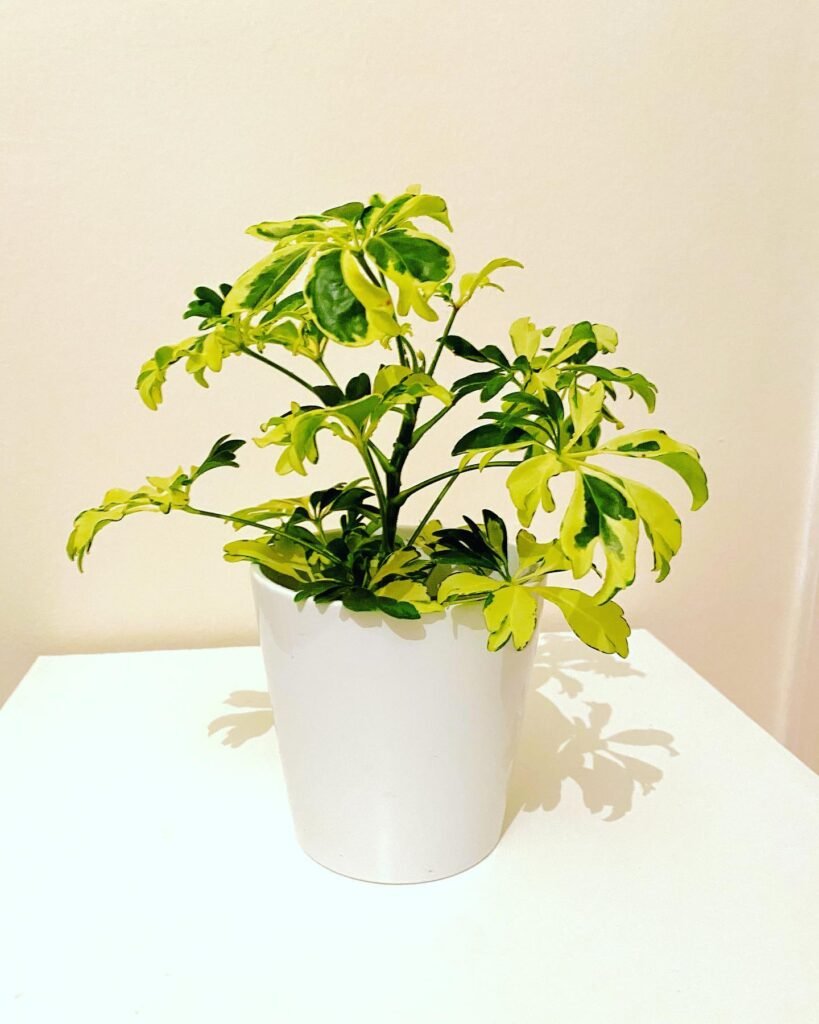
Schefflera Janine, commonly known as the Umbrella Plant, is an indoor plant that thrives in bright, indirect sunlight. Its light requirements are essential for its optimal growth and overall health.
To provide the right amount of light, place your Schefflera Janine near an eastern or northern-facing window. These locations offer ample natural light without exposing the plant to direct sunlight, which can cause its leaves to burn and turn brown.
If you’re unable to provide sufficient natural light, you can use artificial grow lights to supplement. These lights mimic the sun’s spectrum and provide the necessary light energy for your Schefflera Janine. Be sure to position the grow lights at an appropriate distance to prevent overheating or damaging the plant.
Note: Finding the right balance of light is crucial for the health and growth of your Schefflera Janine. Monitor your plant closely and adjust its light exposure as needed to ensure it flourishes in its indoor environment.
- Avoid placing the plant in direct sunlight to prevent leaf burn.
- Choose a location near an eastern or northern-facing window for optimal indirect light.
- Supplement with artificial grow lights if natural light is insufficient.

Watering Tips for Schefflera Janine (Umbrella Plant)
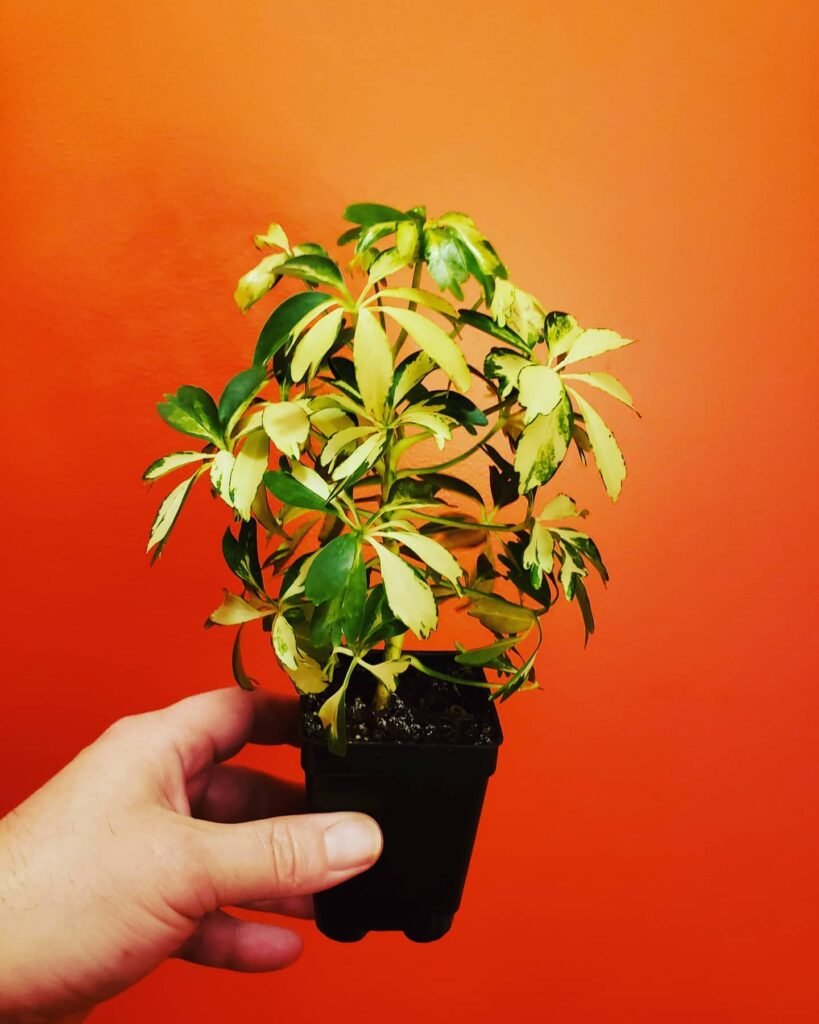
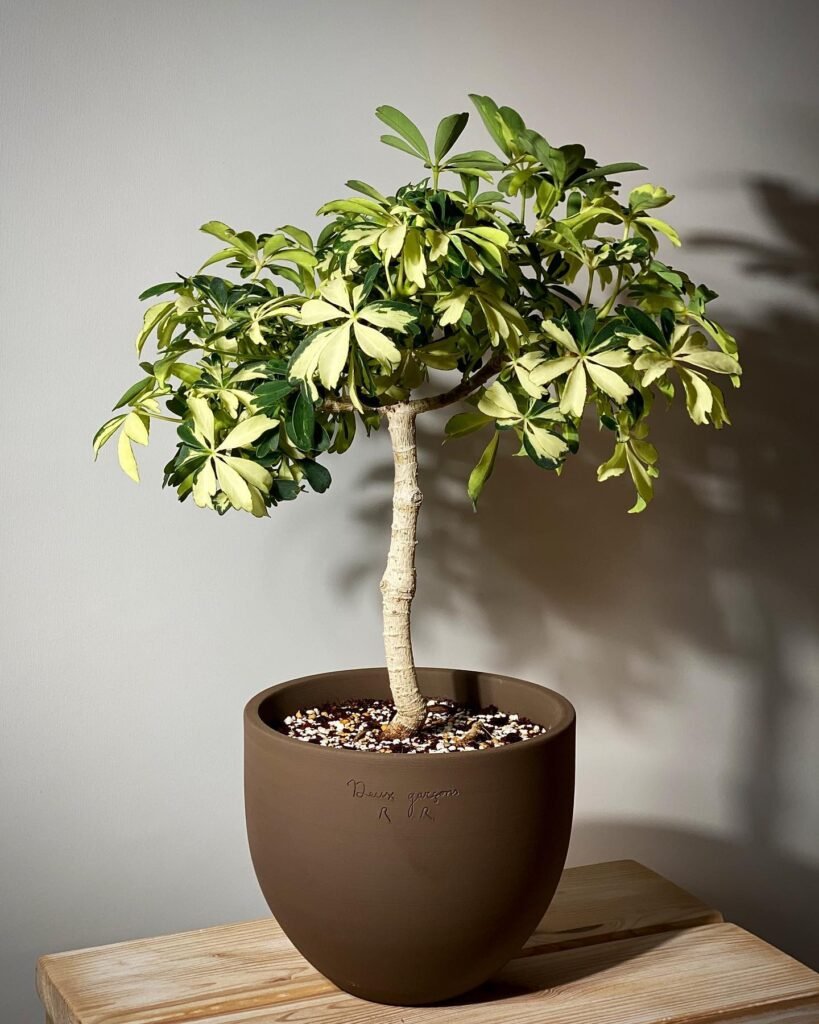
When caring for your Schefflera Janine, proper watering is key to its health and well-being. Here are some essential watering tips to keep your indoor umbrella plant thriving:
- Check the soil: Before watering, always check the top 2cm of soil with your finger to ensure it’s dry. Schefflera Janine prefers slightly dry conditions between waterings.
- Thoroughly soak the soil: When watering, make sure to thoroughly soak the soil rather than just wetting the leaves. This ensures that the water reaches the roots where it is needed the most.
- Watch for proper drainage: Umbrella plants are susceptible to root rot if they sit in waterlogged soil. Ensure that your plant’s container has proper drainage holes to allow excess water to escape.
- Avoid overwatering: Overwatering can be detrimental to Schefflera Janine. As a general rule, water your plant when the soil feels dry to the touch, but be cautious not to overwater.

Fertilizing and Soil for Schefflera Janine
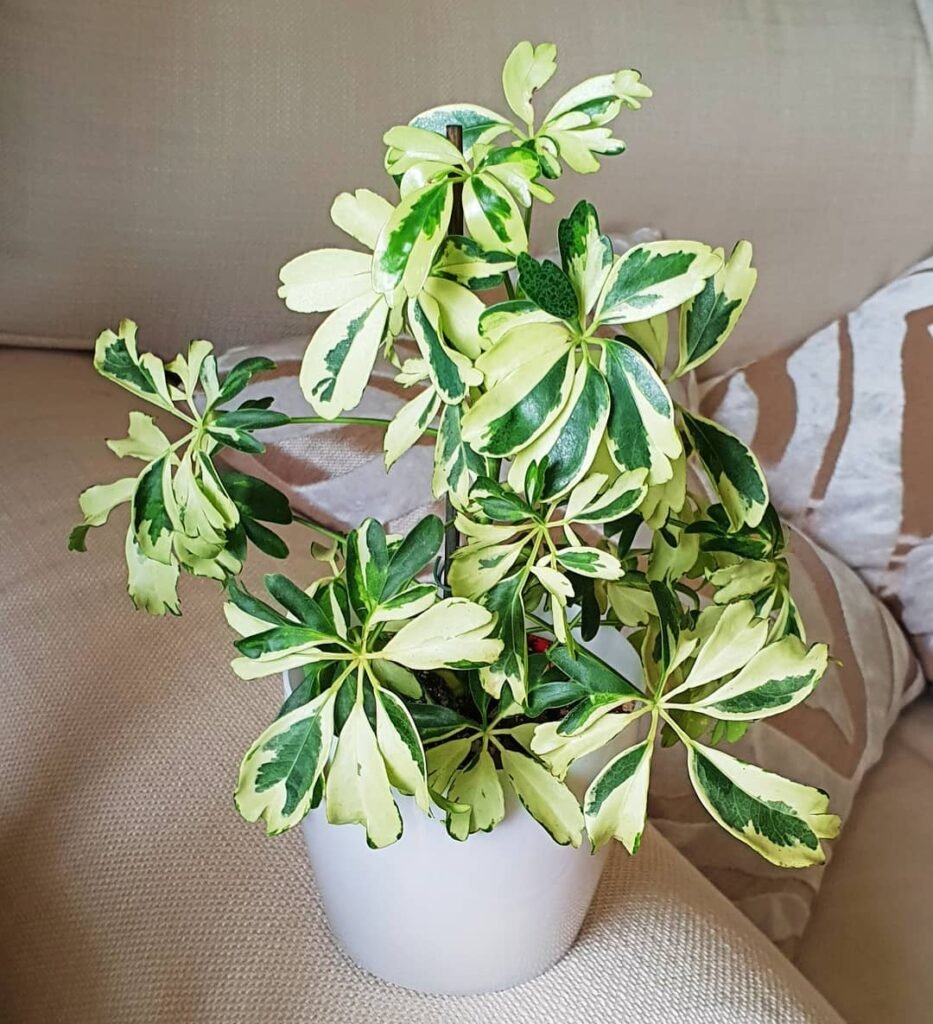
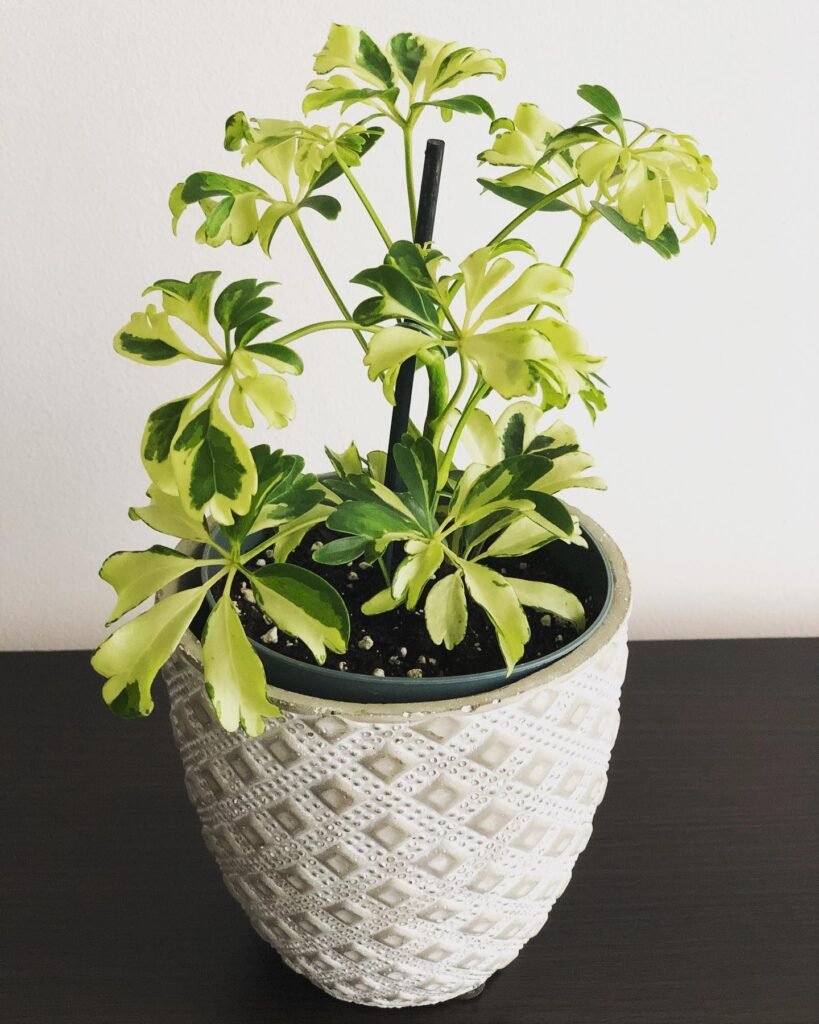
Schefflera Janine, known as the Umbrella Plant, thrives in a rich, well-draining soil that resembles its natural jungle environment. To create the ideal soil mix, combine loam or sand, ensuring proper drainage for optimal growth.
Fertilizing: While fertilizing is not necessary for Schefflera Janine, it can provide additional nutrients that promote the plant’s health and vigor. Consider using a balanced liquid fertilizer specifically formulated for tropical plants.
During the spring and summer months, apply the fertilizer monthly to support active growth. In winter, when the plant’s growth slows down, reduce the frequency to every two months. It’s important to follow the fertilizer manufacturer’s instructions for proper application and dosage to avoid overfertilizing, which can harm the plant.
Soil Requirements: Schefflera Janine’s soil requirements are crucial for its overall well-being. The plant thrives in a soil mix that mimics its natural habitat. A combination of loam and sand provides the ideal balance of water retention and drainage.
- Choose a rich potting mix that includes loam or sandy soil to promote proper moisture levels and aeration.
- Ensure the soil mix is well-draining to prevent waterlogged roots, which can lead to root rot.
- Regularly check the soil moisture by inserting your finger into the top few centimeters of soil. Water only when the soil feels dry to the touch.

Pruning and Maintenance for Umbrella Plant

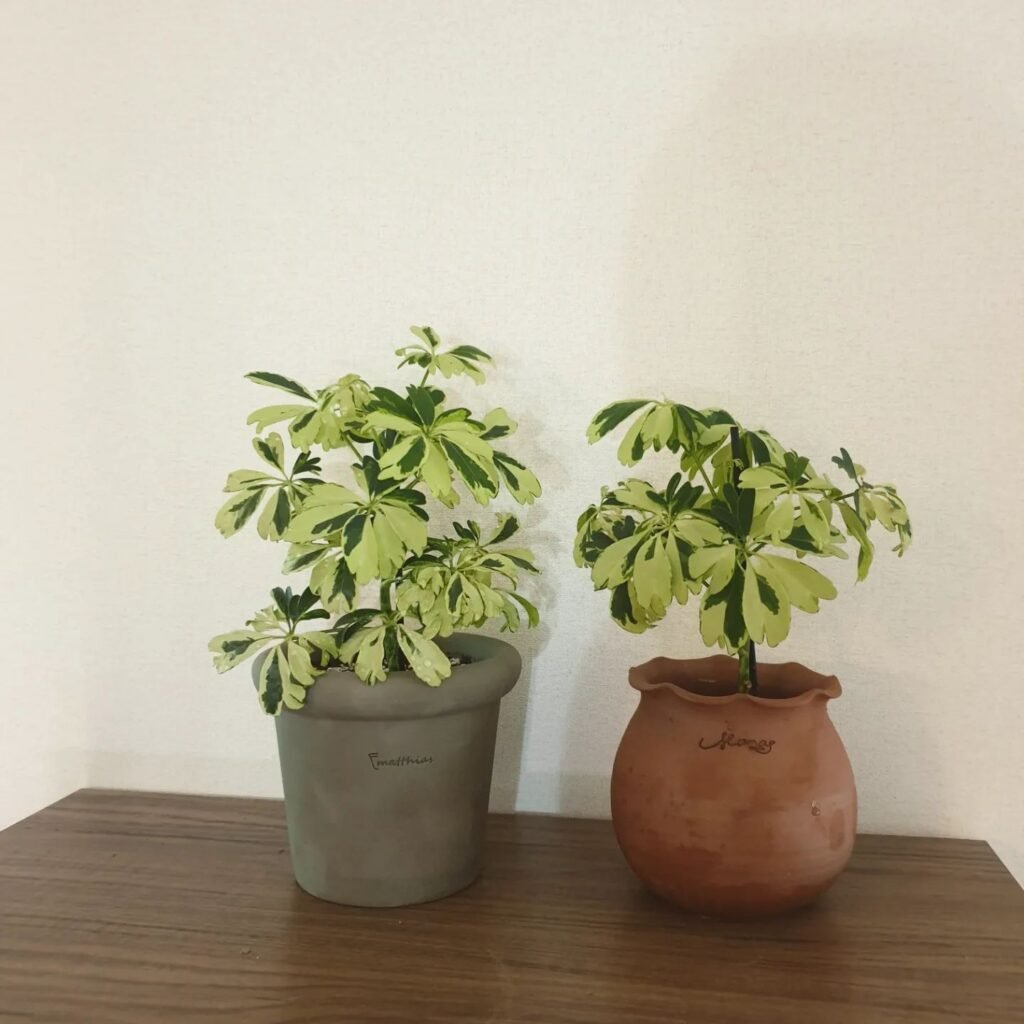
Pruning is not necessary for Schefflera Janine, but it can be beneficial for maintaining a compact and attractive shape. If your plant becomes leggy or overgrown, pruning can help rejuvenate its appearance. To prune, simply trim back any unsightly or straggly stems, cutting them down to 2-3 leaf nodes above the main stem. This encourages new growth and creates a fuller, more shapely plant.
In addition to pruning, regular maintenance is essential for the health and vitality of your Schefflera Janine. Remove any yellow or damaged leaves to keep the plant looking its best. Dust and debris can accumulate on the leaves, so it’s a good idea to clean them periodically with a damp cloth or sponge to maintain their glossy appearance.
It’s important to monitor your Schefflera Janine for any signs of pests or diseases. Common pests that may affect umbrella plants include aphids and spider mites. If you notice any signs of infestation, promptly take appropriate action to control the pests and prevent them from spreading. There are several organic pest control options available, such as insecticidal soap or neem oil.

Propagating Schefflera Janine (Umbrella Plant)


To propagate Schefflera Janine, you can use stem cuttings to create new plants. Start by selecting a healthy stem cutting that is approximately 15cm long. Make a clean cut at a 45° angle just below a leaf node.
Remove the lower leaves from the cutting, leaving only 5-6 leaves at the top. This helps reduce water loss and encourages root development. If desired, you can gently scrape the bottom few centimetres of the cutting to expose the cambium layer, which can further enhance rooting.
To improve the success rate of rooting, dip the cut end of the stem in a rooting hormone powder or gel. This provides the cutting with the necessary hormones to stimulate root growth.
Next, prepare a pot filled with well-draining potting soil. Insert the prepared stem cutting into the soil, ensuring that at least two leaf nodes are buried. Firmly press the soil around the cutting to provide stability.
Place the pot in a warm location with bright, indirect light. Maintain a consistently moist soil by watering when the top inch of the soil feels dry to the touch. Avoid overwatering, as soggy soil can lead to root rot.
After about a month, roots should start to form. You can gently tug on the cutting to check for resistance, indicating that it has established roots.
Once the roots are established, you can transplant the new plant into a larger container or share it with friends and family. Ensure you acclimate the new plant gradually to its new environment to minimize stress.

Repotting Tips for Schefflera Janine
When it comes to caring for your Schefflera Janine, repotting is an important task that promotes healthy growth and prevents the plant from becoming rootbound. Repotting should be done when the plant outgrows its current container or when you notice the roots starting to poke through the drainage holes.
Here are some helpful tips for successful repotting:
- Choose the right pot: Select a slightly larger pot with good drainage. This will give the roots more room to grow and prevent waterlogging.
- Prepare the potting mix: Fill the new pot with a well-draining potting mix. A mixture of peat moss, perlite, and regular potting soil works well for Schefflera Janine.
- Remove the plant gently: Carefully remove the plant from its current pot by gently loosening the roots. Be cautious not to damage the roots or stems during this process.
- Place it in the new pot: Position the plant in the new pot, ensuring that it sits at the same level as it was in the previous pot. This will help maintain stability and prevent root exposure.
- Backfill and stabilize: Fill the gaps around the plant with the potting mix, ensuring that the soil is evenly distributed. Tamp it down lightly to stabilize the plant.
- Water thoroughly: After repotting, give the plant a thorough watering to help settle the soil and eliminate any air pockets around the roots.
After repotting, continue with regular care and maintenance for your Schefflera Janine, including providing proper light, watering, and fertilizing. Repotting every 1-2 years will help your plant thrive, promote healthy root development, and ensure that it has enough space to grow. With these repotting tips, your Schefflera Janine will continue to be a stunning addition to your indoor plant collection.
 Did you know Schefflera Janine can show ‘guttation’, where droplets form on leaf edges? This natural process helps it manage excess water, showcasing its unique water regulation system.
Did you know Schefflera Janine can show ‘guttation’, where droplets form on leaf edges? This natural process helps it manage excess water, showcasing its unique water regulation system.
Common Problems and Solutions for Schefflera Janine
Schefflera Janine is generally a hardy and resilient plant, but it can encounter some common problems. Here are a few issues you may come across while caring for your Schefflera Janine and the solutions to resolve them:
1. Curling or Drooping Leaves
If you notice that the leaves of your Schefflera Janine are curling or drooping, it is a sign that the plant is not receiving enough water. Adjust your watering schedule accordingly and ensure that the soil is evenly moist. Check the top layer of soil with your finger and water when it feels dry to the touch. Avoid overwatering as it can lead to root rot.
2. Yellow Leaves that Fall Off
Yellow leaves that fall off the plant are usually a sign of overwatering. To prevent this, allow the soil to dry out between waterings. Only water when the top layer of soil is dry. This helps prevent waterlogged roots, which can lead to leaf yellowing and dropping. Remember that Schefflera Janine prefers slightly dry conditions over consistently wet soil.
3. Browning or Discolored Foliage
When the foliage of your Schefflera Janine starts to brown or become discolored, it may indicate sunburn or a fungal infection. Provide shade from direct sunlight by moving the plant to a location with filtered or indirect light. If a fungal infection is suspected, treat it with appropriate remedies, such as a fungicide or neem oil, following the manufacturer’s instructions. Keeping the humidity levels balanced can also help prevent fungal issues.
4. Pest Infestations
Schefflera Janine can be susceptible to pests like aphids or spider mites. If you observe tiny bugs or webbing on the plant, take immediate action to control the infestation. Use insecticidal soap or neem oil to treat the affected areas, following the instructions on the product label. Regularly inspect your plant for signs of pests, and if detected, isolate the plant to prevent the infestation from spreading to other plants.
Helpful Videos about Schefflera Janine (Umbrella Plant)
Check out these great videos I found about looking after the Maidenhair Fern, or Adiantum raddianum. They’re full of simple tips that make caring for this pretty plant easy. They’re just right for anyone new to gardening!
FAQ about Schefflera Janine (Umbrella Plant)

Curious about the finest ways to look after your Schefflera Janine, also known as the Umbrella Plant? You’ve landed in just the right place! I’ve put together all the crucial tips to help you care for your plant effortlessly. Whether it’s getting the watering just right or tackling common issues, you’re well covered here.
Schefflera Janine thrives in bright, indirect light. Direct sunlight can scorch its leaves, while too little light can lead to leggy growth. A spot near a window with filtered light is ideal.
Water when the top inch of soil feels dry. Over-watering can lead to root rot, so ensure good drainage. In winter, water less frequently.
Use a well-draining potting mix. Adding perlite or sand improves drainage, vital for preventing root rot.
Signs include yellowing leaves, drooping, and soft, mushy stems. Allow the soil to dry out more between waterings.
In the UK, it’s best grown indoors due to its preference for warmer temperatures. During summer, it can be placed outside in a shaded spot but should be brought in before temperatures drop.
It prefers temperatures between 15-24°C. Avoid sudden temperature changes and keep it away from drafts.
Feed with a balanced, water-soluble fertilizer every 4-6 weeks during the growing season (spring and summer). No need to feed in winter.
Prune in spring or summer to maintain shape and encourage bushier growth. Use clean, sharp scissors to cut just above a leaf node.
Leaf drop can be caused by over-watering, under-watering, or a significant change in temperature or light. Assess care routines to identify and correct the issue.
Yes, you can propagate by cuttings. Take a stem cutting with at least 2-3 leaf nodes, dip in rooting hormone, and plant in moist soil. Keep warm and covered to retain humidity.
Repot every 2-3 years or when roots outgrow the pot. Spring is the best time for repotting to a slightly larger container.
Common pests include aphids and spider mites. Treat infestations with insecticidal soap or neem oil, ensuring to cover all parts of the plant.
It prefers higher humidity but can tolerate average home conditions. Mist regularly or use a pebble tray to increase humidity.
Yes, it can be toxic if ingested by pets. It’s best to keep it out of reach of cats and dogs.
Slow growth can be due to low light, under-feeding, or cold temperatures. Ensure it’s getting the right conditions for its needs.
Remove the plant from its pot, trim away any black, mushy roots, and repot in fresh, well-draining soil. Reduce watering and ensure the pot has good drainage.
I trust this FAQ has helped you get a better handle on caring for your Adiantum raddianum, or Maidenhair Fern. If you’ve got any more questions, feel free to drop them in the comments. I’m here to help.
Happy gardening! 🌿

